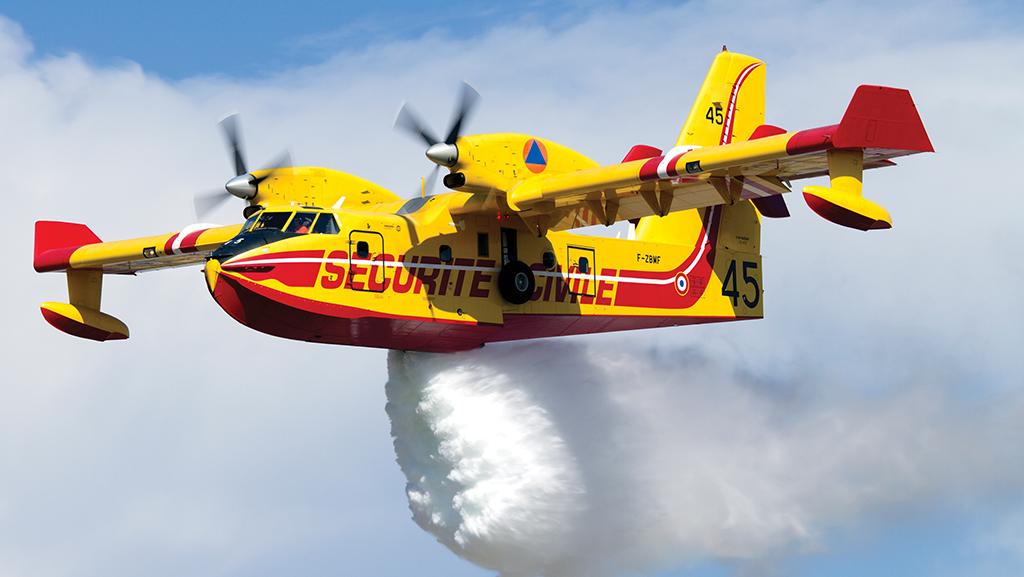This article is published in Aviation Week & Space Technology and is free to read until May 31, 2024. If you want to read more articles from this publication, please click the link to subscribe.

The arrival of the DHC-515 in Europe will supplement CL-215T and CL-415 aircraft in service with Europe’s air forces and civil protection agencies such as France’s Securite Civile.
A wave of orders from Europe looks set to enable the restart of production for one of Canada’s most famous aviation exports.
In the coming months, six European countries with financial support from the European Commission (EC) are expected to have finalized contracts for 24 De Havilland Canada DHC-515s—a modernized version of the distinctive Canadair, later Bombardier CL-215, family of amphibians.
- 12 DHC-515s are being funded by the European Commission
- Airframer is waiting for 20 orders to start production
European air forces and civil protection organizations operate more than half the global fleet of CL-215-family aircraft, most of them turboprop-powered CL-215Ts and CL-415s.
These heavily utilized machines—usually painted in high-visibility red-and-yellow schemes and often known as Canadairs, Super Scoopers or Peli-cans—skim rivers, lakes and seas to snorkel up water and then drop it on forest fires across Southern Europe.
Now, with the planned introduction of the DHC-515, the European fleets will be modernized and strengthened as governments face the increased threat of wildfires driven by rising summer temperatures and droughts that have lead to the ravagement of forests, farmland and property. Estimates put the damage from such fires in Europe at $4.1 billion in 2023.
“Forest fires are a growing problem for Europe,” an EU official tells Aviation Week. “The fire season is becoming longer and longer, and it is no longer just a Club Med issue but spreading south to north.”
Light firefighting aircraft now have been positioned in Germany and Sweden, officials say, a requirement that was “unthinkable three or four years ago.”
So far, Croatia, Greece and Spain have placed orders for the DHC-515 to add to their existing fleets of CL-215s, CL-215Ts and CL-415s. Croatia has ordered two DHC-515s, while Greece and Spain have ordered seven each. France, Italy and Portugal are expected to sign contracts soon for another eight aircraft.
“This [acquisition] makes us empowered for firefighting activity in Croatia but also an important regional actor when it is necessary to help other European countries,” Croatian Prime Minister Andrej Plenkovic said in announcing his country’s DHC-515 order on March 22.
Of the 24 aircraft being ordered by the six countries, 12 are being funded by €600 million ($643 million) from the EC's RescEU civil protection initiative, which previously created a temporary pool of firefighting aircraft from member states that can be deployed across Europe should civil protection agencies require additional assistance. Negotiations among the member states, the EC and the manufacturer have been ongoing for several years.
Now, with the funding of two DHC-515s for each of the six countries, RescEU will have its own dedicated fleet of aircraft that can be deployed anywhere in Europe.
“RescEU are not the first responders,” the EU official notes. “We are the safety net, supporting the member states once they are overwhelmed.”
The EU-funded aircraft will be operated and maintained by the individual countries for national purposes, but the aircraft can be retasked by RescEU if required. However, EU officials note that any decision to deploy the aircraft is taken in conjunction with member states, so aircraft will not be mobilized from a country that needs them at the time. The idea is that the 12-strong fleet can be deployed to three consecutive requests for assistance.
“The nations chose the DHC-515 because they are familiar with the aircraft,” the EU official says. “They have the personnel, maintenance [and] spare parts; it is a relationship they wanted to continue.”
The DHC-515s are being ordered through government-to-government agreements with the Canadian Commercial Corp., a Canadian government contracting agency acting on behalf of De Havilland Canada.
Development of the DHC-515 was formally launched in March 2022, following the 2016 purchase of the Canadair portfolio of CL-215 and CL-415 amphibians by Viking Air, which was later renamed to De Havilland Canada.
This new version will feature improved performance and reliability due to a new turboprop engine and new avionics, but the company so far has been tight-lipped on details. De Havilland Canada has begun preproduction activities on the DHC-515, company officials tell Aviation Week. Although orders for 16 of the 24 aircraft are under contract, the OEM is waiting until 20 have been ordered before it signs purchase orders for components from its supply chain to start production.
Deliveries of the new aircraft are expected to commence in late 2027.



